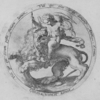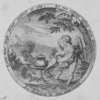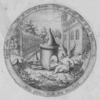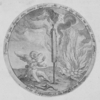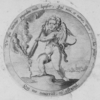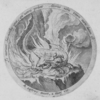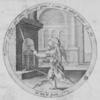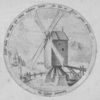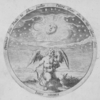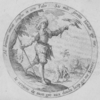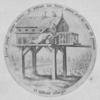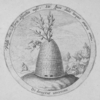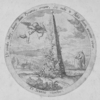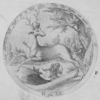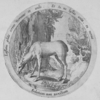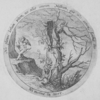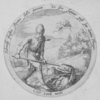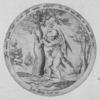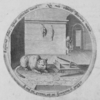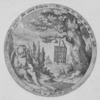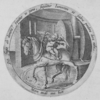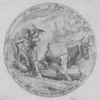Noctua ut in tumulis, super utque cadavera bubo [24]
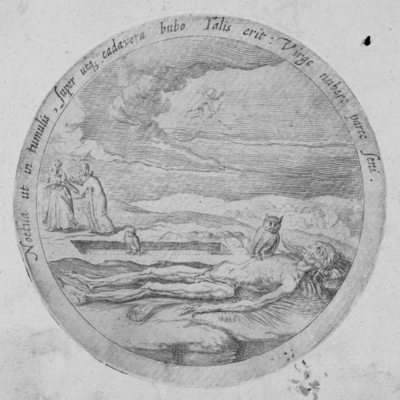
24.
Noctua ut in tumulis, super ut’que cadavera Bubo.1



Ick ben een levend’ lijck/ nu dinck ick eerst om minnen
Als ander houden op/ zoo gae ick maer beginnen/
De doot is voor de poort/ de minne woont int hert
Ick smaeck noch voor mijn doot de liefelicke smert/
De doodt end’ ic zijn een/ nu dinck ick om te leven:
Mijn leven dat beghint/ alst my wilt gaen begheven.
Het comt oft vroech oft laet/ ick vreesde Voor de doot.
En cryghe voor mijn graff mijns alderliefste schoot2.
Als ander houden op/ zoo gae ick maer beginnen/
De doot is voor de poort/ de minne woont int hert
Ick smaeck noch voor mijn doot de liefelicke smert/
De doodt end’ ic zijn een/ nu dinck ick om te leven:
Mijn leven dat beghint/ alst my wilt gaen begheven.
Het comt oft vroech oft laet/ ick vreesde Voor de doot.
En cryghe voor mijn graff mijns alderliefste schoot2.

Translations
 |
Als een nachtuil in de graven en een oehoe boven de kadavers. |
 |
As a nightowl in burial chambers and an eagle owl over dead bodies. |
 |
Als een nachtuil in de graven en een oehoe boven de kadavers, zo zal zij zijn. Meisje trouw niet met een oude man. |
 |
As a nightowl in burial chambers and an eagle owl over dead bodies, thus she will be. Girl, do not marry an old man. |
Literature
-
Henkel and Schöne, Emblemata
 , col. 891
, col. 891
-
Praz, Seventeenth-Century Imagery
 , p. 98
, p. 98
Sources and parallels
- Same emblem in 1608 edition: Noctua ut in tumulis, super utque cadavera bubo [24] (in: Daniël Heinsius, Emblemata amatoria (1607/8))
[Compare
![Compare [compare]](/static/images/compare2.gif) ]
]
- Source for the motto, latin subscriptio, pictura and entire emblem: Alciato, Book of Emblems
 , embl. 117
, embl. 117
- The same emblem as above, but with another pictura (better resemblance):
Alciato, Emblemata (1550)
 , embl. 117
, embl. 117 - Source for the metaphor of an aged lover: Ovidius, Amores I
 , bk/poem.
I/9
, bk/poem.
I/9 -
Parallel in the 1616 edition (motto the same, subscriptio more or less the same, modified pictura (an addition of
a castle, the shrubs are clearly visible)): Noctua ut in tumulis, super utque cadavera bubo. [48] (in: Daniël Heinsius, Ambacht van Cupido, from: Nederduytsche poemata (1616))
[Compare
![Compare [compare]](/static/images/compare2.gif) ]
]
-
Use of the same latin subscriptio: Ex morte levamen. [47] (in: Jacob Cats, Sinne- en minnebeelden (1627))
[Compare
![Compare [compare]](/static/images/compare2.gif) ]
]
-
Parallel for the pictura (corpse): Nemo dolens patet libidini. [51] (in: Jacob Cats, Sinne- en minnebeelden (1627))
[Compare
![Compare [compare]](/static/images/compare2.gif) ]
]
-
Parallel for the pictura (corpse): Nemo dolens patet libidini. [50] (in: Jacob Cats, Proteus (1618))
[Compare
![Compare [compare]](/static/images/compare2.gif) ]
]
References, across this site, to this page:
- Nemo dolens patet libidini. [50] (in: Jacob Cats, Proteus (1618))
- Ex morte levamen. [47] (in: Jacob Cats, Sinne- en minnebeelden (1627))
- Nemo dolens patet libidini. [51] (in: Jacob Cats, Sinne- en minnebeelden (1627))
- Noctua ut in tumulis, super utque cadavera bubo [24] (in: Daniël Heinsius, Emblemata amatoria (1607/8))
- Noctua ut in tumulis, super utque cadavera bubo. [48] (in: Daniël Heinsius, Ambacht van Cupido (1613))
- Noctua ut in tumulis, super utque cadavera bubo. [48] (in: Daniël Heinsius, Ambacht van Cupido, from: Nederduytsche poemata (1616))
Iconclass
A nightowl in a shallow grave and an eagle owl on a corpse; an old man and a young woman in the background; a cupid shooting a dart from the sky- owls (+ animals used symbolically)
[25F34(+1)]

- flying
[31A2762]

- adolescent, young woman, maiden
[31D13]

- old man
[31D16]

- the corpse
[31E3]

- one-sided courting
[33C31]

- woman in flight (one-sided courting)
[33C311]

- grave, tomb
[42E31]

- (personifications and symbolic representations of) Love; 'Amore (secondo Seneca)' (Ripa) (+ emblematical representation of
concept)
[56F2(+4)]

- proverbs, sayings, etc. (with TEXT)
[86(NOCTUA UT IN TUMULIS, SUPER UTQUE CADAVERA BUBO)]

- Cupid shooting a dart
[92D1521]

![[H O M E : Emblem Project Utrecht]](/static/images/rd-small.gif)


